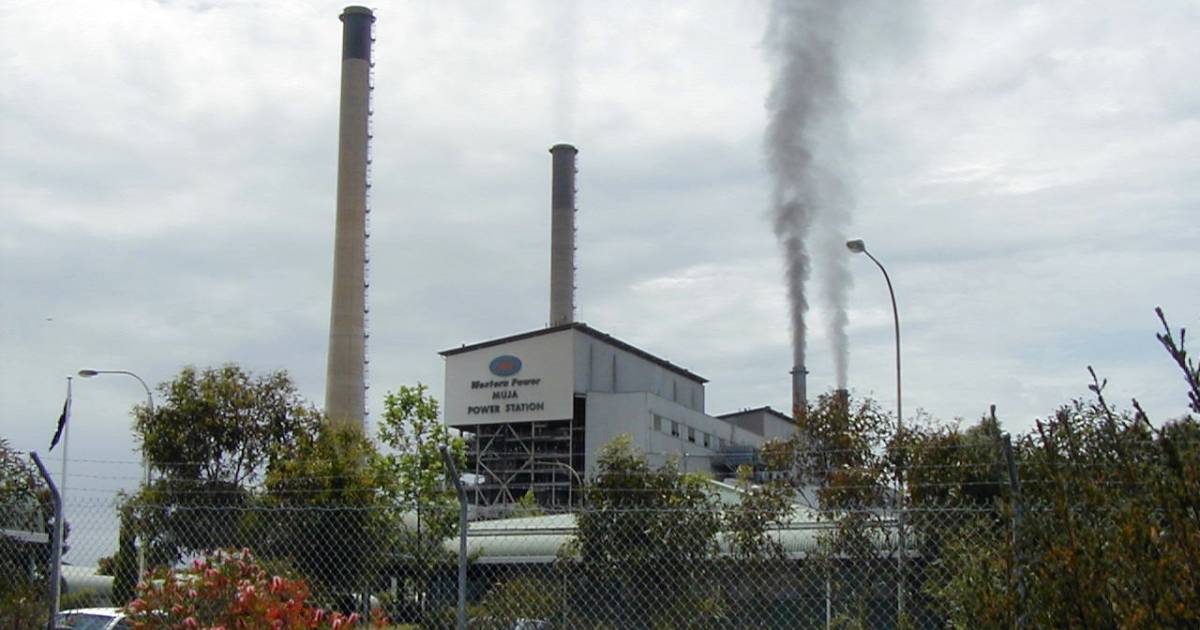
Muja Power Station circa 2001 – Image: Nachoman-au, CC BY-SA 3.0.
Rooftop solar power and other renewables have put the final nails in WA’s state-owned coal-fired power stations.
Western Australian Premier Mark McGowan and Energy Minister Bill Johnston announced yesterday afternoon Collie Power Station will close in late-2027 and Muja D in late-2029.
Muja is comprised of four 60 MW units (Stages A-B), two 200MW units (Stage C) and two 227MW units (Stage D). Stages A and B were permanently closed in 2017 and 2018 following a previous mothballing that occurred after hundreds of millions of dollars were spent in refurbishing them. In 2019, the WA Government announced Stage C Unit 5 is to close on October 1, 2022 and Unit 6 on October 1, 2024.
As for Collie Power Station, it’s a 340MW coal burner that, like Muja Power Station, runs on fuel dug up from the Collie coal fields. The writing has been on the wall for Collie power station for some time.
The reason given for giving coal power the final boot:
“The reality is our current electricity system is becoming increasingly unsustainable due to the uptake of rooftop solar and growing demand for renewable options for generation,” said Premier McGowan.
The energy mix is becoming increasingly variable – and that doesn’t suit coal power.
Coal’s Continuation = More Expensive Electricity
Western Australian households and businesses have suffered regular electricity price rises, but this year’s increase is comparatively modest.
However, the Premier said if the status quo remained, households and businesses would be staring down the barrel of more painful price hikes in the years ahead – with average annual household electricity costs projected to jump by more than $1,200 by 2030. In the absence of major increases, WA taxpayers would be forced to fund billions of dollars (more) in subsidies to keep these coal-fired clunkers running.
$3.8 Billion Renewables Spend
The McGowan Government said it is to undertake one biggest infrastructure projects ever seen in the state – a projected $3.8 billion investment in renewable generation and energy storage in the South West Interconnected System (SWIS)1. This, it says, will not only ensure continued supply stability and affordability, but also create thousands of additional jobs in regional Western Australia2.
“The amount of rooftop solar coming online currently in WA is roughly the equivalent of adding a new coal-fired generation unit every year,” said WA Energy Minister Bill Johnston.
More than 429,000 small scale (<100kW) solar systems had been installed across the state by the end of April this year. While Western Australia’s feed-in tariffs for surplus solar energy exported to the grid are really crappy, fierce competition between solar installers in Perth in particular keeps system prices down to among the lowest in the world (if not the lowest); making installing solar panels in Perth a very good investment.
Minister Johnston stated the popularity of rooftop solar in Western Australia was putting “unprecedented pressure” on the SWIS3.
“Our new investment in the South West Interconnected System represents an extraordinary investment in the future of our electricity system, including a massive reduction of Synergy’s carbon emissions.”
The investment is expected to pay for itself by 2030-31 “relative to status quo of increasing electricity subsidies”.
On a related note, Minister Johnston released WA’s Distributed Energy Resources (DER) Roadmap’s two-year progress report last week, stating its implementation is “on track“.
What About Gas?
While the eastern states are in the midst of a gas crisis, the McGowan Government is gloating over enjoying the benefits of action taken by a previous state Labor Government back in 2006 that resulted in 15 per cent of LNG available for export reserved for domestic use. On this front and totally ignoring emissions and such, it appears WA is the smartest state in the room.
There was no talk yesterday of shutting down Synergy’s gas-fired power stations prematurely as they will be needed during this transition, but the State Government has committed to not commissioning any new gas-burners on the SWIS – after 2030.
Footnotes
- The SWIS service area covers most of Western Australia’s population – from Kalbarri in the north to Kalgoorlie in the east and Albany in the south. ↩
- On a related note, the McGowan Government announced yesterday it will invest an additional $547.4 million in Collie – home to around 7,200 – building on more than $115 million already committed ↩
- New and upgraded solar installations connected to the SWIS have been required to incorporate remote shutdown capabilities since February this year. But it’s not clear how often this has been used since and how broadly, if at all. It’s a tool to be used for short periods as a last-resort for maintaining network stability. ↩

 RSS - Posts
RSS - Posts



Hi Michael
Sorry – just a (minor) nitpick – regarding your footnote #1…!
I don’t think most of us here in WA would consider Kalbarri to be ‘in the north’, nor Kalgoorie ‘in the east’. To the north of Perth, certainly, and to the east.
But we can drive to Kalbarri or Kalgoorlie or Albany within about 6 hours or so – more like 2-3 days to the Pilbarra – and another day or so on to the Kimberley (e.g. Broome – then further again to Derby).
But certainly, Albany and Esperance (quite a trek east of Albany) are ‘in the south’.
This is one big State, and Perth is well, well south and west of it’s centre.